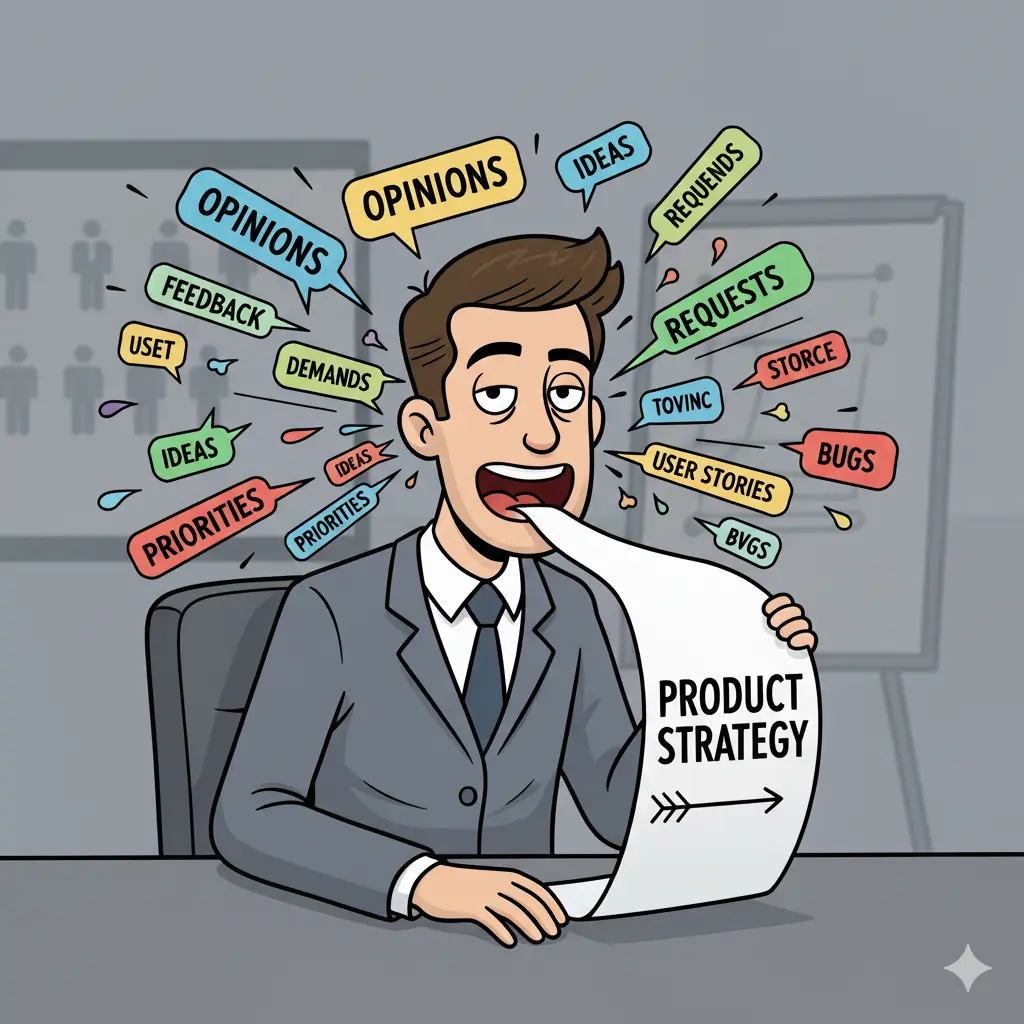
The AI Productivity Paradox: Why Saving Time with AI Makes PMs More Exhausted
Despite AI time savings, product managers face decision fatigue from constant validation loops and cognitive offloading
The numbers tell a success story: AI tools like GPT-4 and Claude are saving product managers up to eight hours per week on average. Your time tracking software shows the green metrics. Your capacity planning looks optimized. Yet here you are, feeling more mentally drained than before the AI revolution. You’re not alone, and you’re definitely not imagining things.
This isn’t about being bad at using AI tools. It’s about facing the AI decision tax, the constant, exhausting mental calculations required to manage AI outputs. Every generated spec, every AI-summarized user feedback, every draft requirement document comes with an invisible price tag: cognitive overhead that traditional productivity metrics fail to capture.
The Eight-Hour Mirage: When Time Saved Doesn’t Equal Energy Gained
Let me paint you a familiar picture. One product manager tracked their AI usage meticulously and discovered they were saving roughly eight hours weekly on documentation writing, user feedback analysis, and meeting summarization. The data looked perfect. The reality felt different:
“Every AI output is a judgment call”, they explained. “Is this response good enough and aligned with my target? Do I regenerate? How deep do I verify? I’m making these micro-decisions 50+ times a day and honestly, it’s exhausting.”
This perfectly captures the first layer of the paradox: time savings don’t automatically translate to reduced mental load. In fact, they often redistribute that load into smaller, more frequent cognitive tasks that bypass our natural decision-making rhythms.
The research from Aalto University ↗ reveals a crucial insight: when examining how participants used ChatGPT, researchers found that “people just thought the AI would solve things for them. Usually there was just one single interaction to get the results, which means that users blindly trusted the system.” This creates what psychologists call cognitive offloading, when users outsource all their thinking to AI tools.
The Power Tools Analogy: Speed Doesn’t Eliminate Craftsmanship
One commenter nailed the experience with a brilliant woodworking analogy: “My dad is an avid woodworker and he tells me about the time when power tools first hit woodworking. You could cut faster, sand smoother, build more in a day. But the craftsman still had to choose the design, feel the wood, check the alignment… but just that it could all be done now at 10x speed.”
This perfectly illustrates the core issue: AI amplifies execution but doesn’t reduce responsibility. The judgment, taste, and ownership of outcomes still sit squarely with the product manager. The model can draft, but it can’t decide.
The Reality of Prompt Engineering: Cognitive Work Under Disguise
Designing context, validating output, catching drift, re-focusing the model, none of this shows up in time tracking software, but it definitely shows up in how you feel at the end of your day. One developer perfectly captured this hidden labor: “The real gains of AI are not in the speed of development. A good senior can often fix a bug or develop a small feature faster than AI. The real gain of AI is in the cognitive load reduction.”
Except when it’s not.
Many PMs experience what’s been described as the “sunk-cost fallacy loop”, you’ve invested so much time prompting and iterating that abandoning the AI approach feels like wasted effort, even when manually completing the task would be faster. You ask yourself:
- Do I understand exactly the specifications I’m trying to implement?
- Do I have an exact plan for implementing my changes?
- What is the current abstraction level I should be prompting at?
- What other information am I lacking?
These questions represent the invisible mental scaffolding required to make AI collaboration effective, and exhausting.
The Unseen Cost: Cognitive Offloading and the Dunning-Kruger Effect
Research from Aalto University reveals another hidden cost: when it comes to AI, the Dunning-Kruger effect vanishes. Instead, users consistently overestimate their performance across all skill levels. The study published in Computers in Human Behavior found that “higher AI literacy brings more overconfidence” rather than better calibration.
This creates a dangerous double-whammy: you’re not only managing more decisions faster, but you’re also potentially overestimating your effectiveness while doing so. The combination creates perfect conditions for mental exhaustion.
The Parkinson’s Law Problem: Saved Time Expands to Fill Expectations

Perhaps the most insidious aspect of this productivity paradox comes from leadership expectations. With Agile methodologies, work could be deferred to the next sprint. Now there’s pressure because technically you could prompt AI at virtually any time of day or night and unblock tomorrow’s work, and leadership knows this and expects it.
As one PM observed: “My capacity expanded, however, so did everyone’s expectations. I’m not working less, just cramming more into the same hours with additional context switching.”
This isn’t just an individual productivity issue, it’s becoming an organizational expectation problem. The very flexibility that makes AI appealing becomes a source of constant availability pressure.
The AI-Resilient Product Manager: Strategies for Surviving the Paradox
So how do we navigate this new reality without burning out? The solution isn’t abandoning AI, it’s using it more strategically.
1. Define Your “Orbit of Impact”
As leadership expert Fay Niewiadomski suggests for combating decision fatigue in executives, we need to “ruthlessly define our orbit of impact.” Identify the three to five decisions that fundamentally impact your product’s trajectory. Everything outside that orbit should follow the DAD principle: Discontinue, Automate, Delegate.
2. Schedule AI Interactions Like Meetings
Don’t let AI become an always-available distraction. Batch your AI interactions during your peak cognitive hours. One PM found success by treating AI conversations like scheduled meetings rather than constant interruptions. This reduces context switching and preserves mental energy for strategic thinking.
3. Implement Cognitive Checkpoints
Before diving into prompt iteration, ask yourself those four critical questions:
- Do I understand exactly what I need?
- Do I have an implementation plan?
- What’s the right abstraction level for this prompt?
- What information am I missing?
This small pause prevents the “sunk-cost fallacy loop” and ensures you’re using AI intentionally rather than reactively.
4. Embrace the Woodworking Mindset
Remember that AI is your power tool, not your replacement. As one commenter observed: “The introduction of power tools made everything faster, but the craftsman still had to make the same judgment calls, just at 10x speed.” Your expertise in product strategy, user empathy, and business context remains your most valuable asset.
5. Measure What Actually Matters
Stop tracking just time saved. Start tracking cognitive load metrics: How many judgment calls per AI interaction? How much mental rework is required? How often do you second-guess AI outputs? These qualitative metrics matter more than raw time savings.
The Human-Centric Future
The irony is profound: we’re creating tools meant to reduce cognitive load, only to discover they’re creating new forms of it. The PM role, which has always balanced technical understanding with human empathy, now faces its most challenging integration yet.
As one industry observer noted, “Most of what we’re seeing now feels more like acceleration than actual transformation.” We’re speeding up execution without necessarily improving judgment, and that gap is where the exhaustion lives.
The path forward requires recognizing that productivity isn’t just about doing more faster, it’s about doing better with less mental taxation. The most successful PMs won’t be those who delegate everything to AI, but those who master the art of when to engage their own expertise versus when to leverage artificial assistance.
Eight hours saved means little if you’re too mentally drained to deploy those hours strategically. The real productivity breakthrough will come not from maximizing AI usage, but from optimizing the human-AI collaboration to preserve what makes us uniquely valuable: our judgment, our empathy, and our ability to make connections that machines still can’t see.
Your time tracking might show eight hours saved, but your brain knows the truth: you’ve traded predictable, concentrated cognitive work for fragmented, high-frequency decision-making. And until we account for that cognitive tax in our productivity calculations, we’ll continue winning the efficiency battle while losing the energy war.



